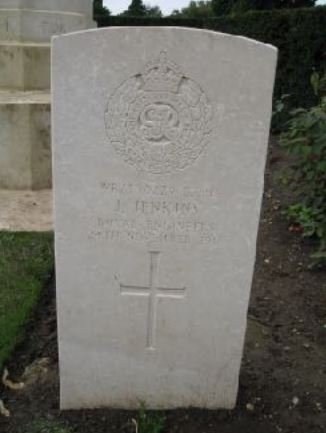Inland Water Transport, Royal Engineers

John Jenkins was born at Longley, Gloucestershire on 14 December 1883. He was one of twelve children born to William Jenkins, a dock labourer, and his wife Ellen (née Howell). Only six children were still living at the time of the 1911 Census, when the family lived at 12 Albion Street, Gloucester. John (then aged 27) appears to have been the eldest of the surviving children and his occupation is noted as a blacksmith with the Gloucester Rail Carriage Works and an Army Pensioner. His siblings were Arthur W (age 24), Sidney Frederick (23), Edith P (20), Albert H (19 and Walter J (10).
John first joined the Army on 11 October 1902, signing on with the Gloucestershire Regiment just two months short of his 19th birthday. He was allocated the number 6592 and committed to three years with the Colours and nine in the Reserve. Prior to enlisting he was employed as a general labourer.
He served in the UK, no doubt undertaking training, from 11 October 1902 until 2 March 1903, after which he served in South Africa until 24 March 1904. Between 6 to 17 November 1903 he was in hospital in Bloemfontein with tonsillitis. His next posting, from 25 March 1904 and 22 January 1906, was in India. His initial period of service fulfilled he was placed in the Army Reserve until 10 October 1905. However, on 15 April 1914 he applied for and was granted a further four years’ extension in the Reserve.
When war broke out in August 1914 he was immediately recalled to the Colours and joined the 1st Battalion, Gloucestershire Regiment at Bordon Camp, Hampshire. On 12 August, as part of 3rd Brigade, 1st Division the Glosters entrained for Southampton and embarked for Le Havre aboard the SS Gloucester Castle, landing the following day. The battalion north to Haulchin where, on 24 August it first encountered the advancing Germans. Thereafter the battalion took part in what became known as ‘The Retreat from Mons’ and arrived and crossed the River Marne on 3 September. Either due to injury or sickness Private John Jenkins returned to the UK on 6 September and remained there until 13 November 1915. He was probably attached to the 3rd (Reserve) Battalion in the North Kent area, maybe acting in a training capacity.
His record states that he spent the period 14 November 1915 to 15 February 1916 with the Mediterranean Expeditionary Force and thereafter from 16 February to 28 August 1916 in Mesopotamia. The 7th Battalion of the Glosters (39 Brigade, 13 Division) served in Gallipoli from June 1915 until January 1916, and after spending a month in Egypt transferred to Mesopotamia and almost certainly John Jenkins service from November 1915 until late August 1916 was with this battalion.
Probably due to sickness he was repatriated to England and spent the period 30 August to 2 November 1916 in Bath War Hospital, suffering from pleurisy. Now being on the strength of the Gloucestershire Regiment Depot, he was posted to the Command Depot, Ballyvonare Camp, County Cork, Ireland on 21 November 1916 before returning to the 3rd (Reserve) Battalion on 1 May 1917.
In the midst of all these movements he married Lilian Mary Williams 7 February 1917 at All Saints Church, Gloucester.
On 12 July 1917 he transferred to the Inland Water Transport (IWT) Department of the Royal Engineers, at Sandwich in Kent and was allocated the number WR/305465 and became a blacksmith’s mate. Unusually and for reasons unknown whilst with this unit his number changed to WR/300229.
The IWT Department had been formed in December 1914, to acquire, despatch and man supply barges being sent from Dover to France. Barges were towed across the Channel loaded with military stores and crews would then pilot them along French and Belgian waterways to stores depots near to the Front. By 1916 the operation had switched to the purpose built Richborough Port, near Sandwich, which also became a training centre for waterway operations on the Western Front, Italy and the Middle East.
On 15 November 1918 Lance Corporal John Jenkins was admitted to Sandwich Military Hospital showing general signs of influenza. This was at the time when the world was experiencing the pandemic known as ‘Spanish Flu’. According to a hospital bulletin his condition remained stable until 19 November when broncho-pneumonia took a hold. Despite all efforts to save him he died at 8.45am on 24 November 1918, aged 35: his wife was present when he died.
His remains were brought back to Gloucester for burial in Gloucester Old Cemetery, along with other casualties of the Great War and a standard CWGC headstone now marks the plot. His wife, Lilian received £33 12s 7d (£33.62) upon his death, which included a £25 gratuity and from 26 May 1919 she received a widow’s pension of thirteen shillings and nine pence (68p) per week She never re-married and died in 1957.
Researched by Graham Adams 31 July 2019
